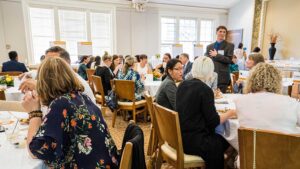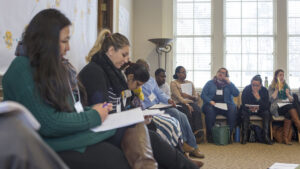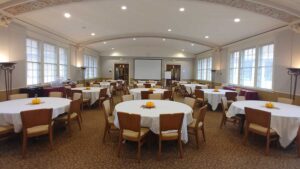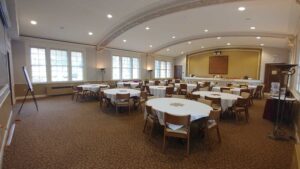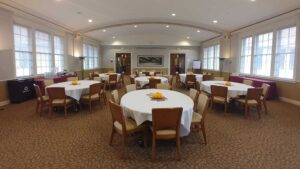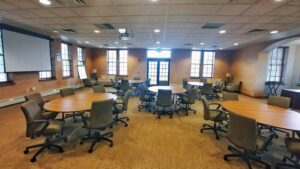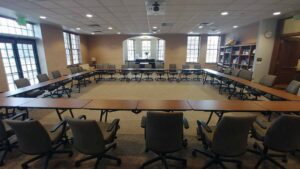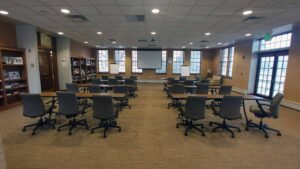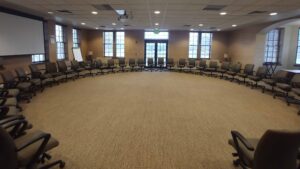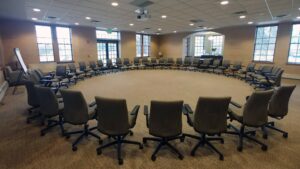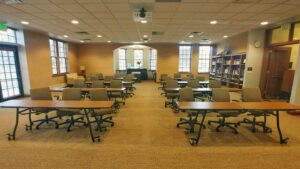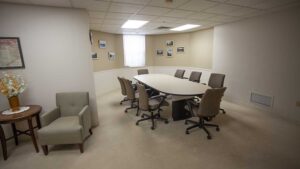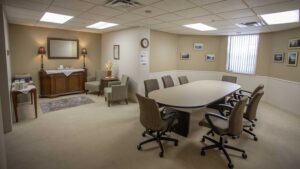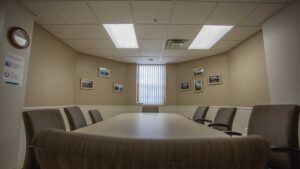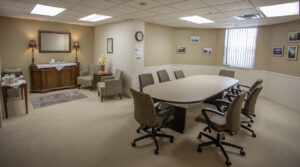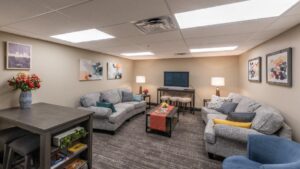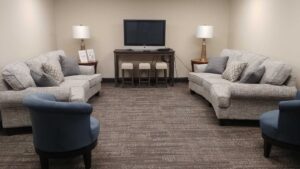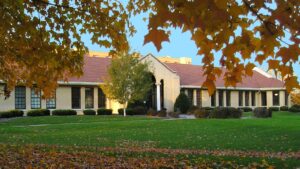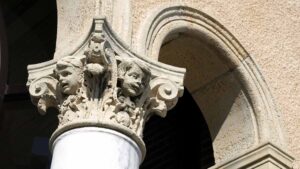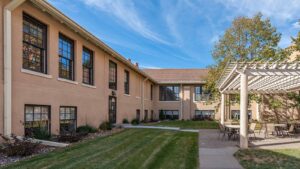Minnesota Humanities
Event Center
Historic Meeting & Retreat Center
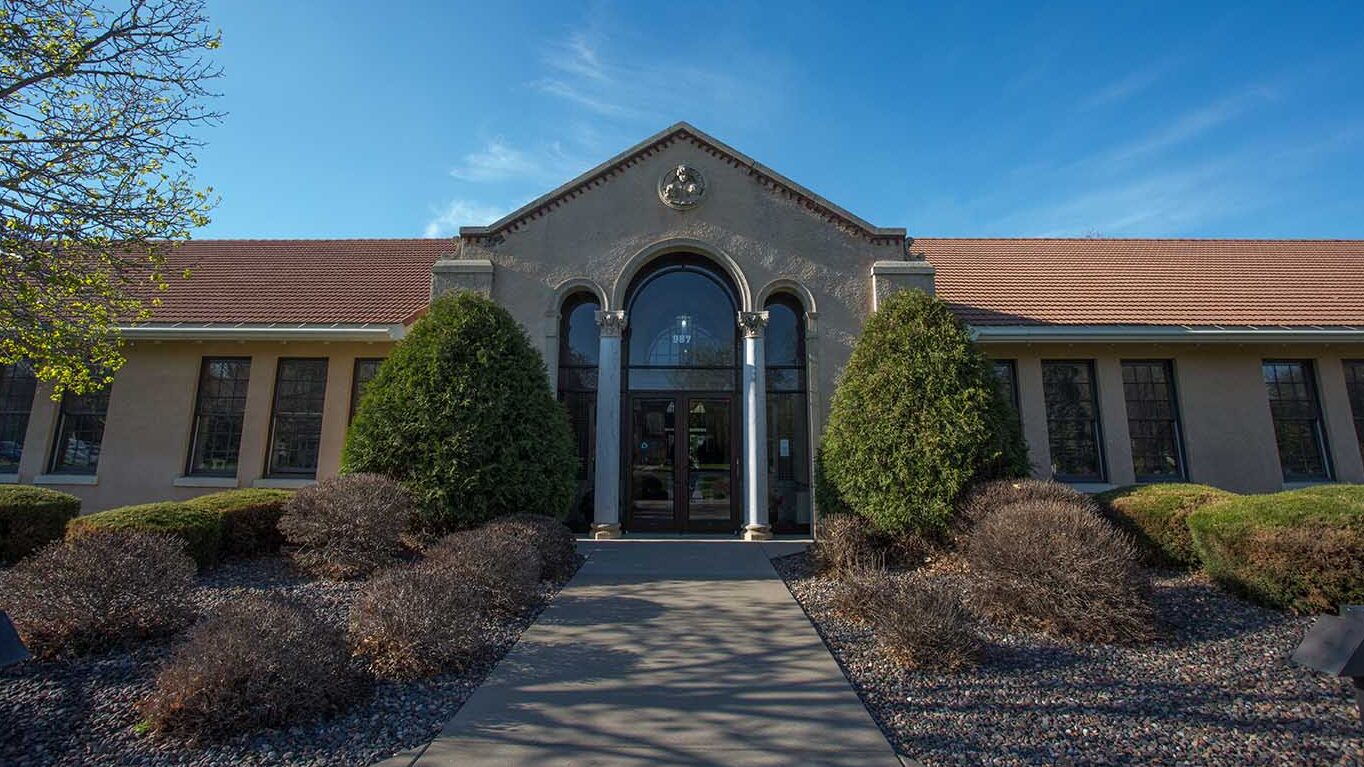
The Minnesota Humanities Event Center is a full service meeting and retreat center centrally located in a historic building in St. Paul. Our flexible event spaces are perfect for your next meeting, retreat, or special occasion. We offer discounted rates for our nonprofit and government customers and a variety of meeting packages to make your meeting planning easier!
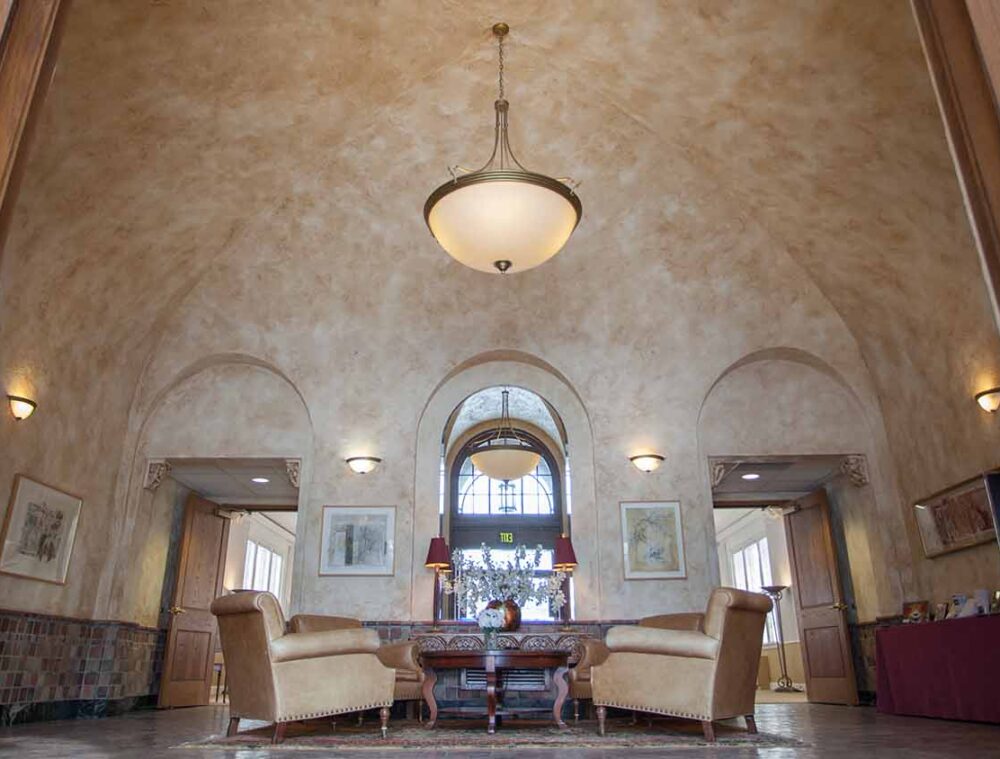
Meeting and Event Spaces
The Minnesota Humanities Event Center is a restored, historic building that has a variety of comfortable and welcoming spaces to fit your needs. Whether it is a special event, an off-site meeting, or a weekend retreat, we have you covered with our unique spaces.
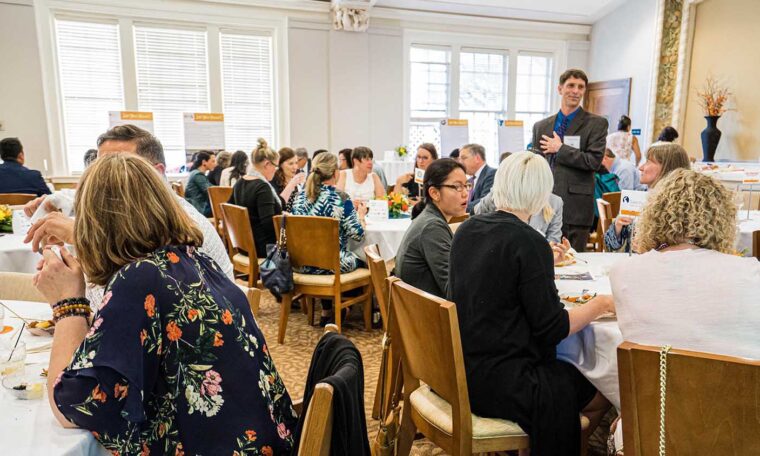
Room Dimensions:
36’x55′
Room Capacities:
Oval Tables = 100
Theatre Style = 120
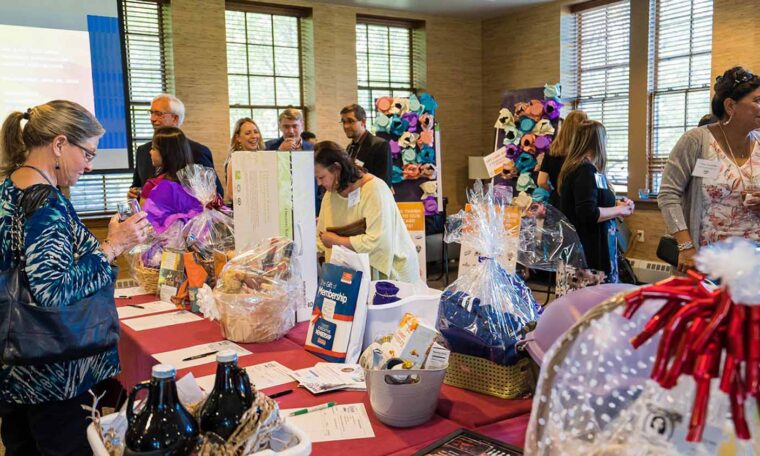
Room Dimensions:
36’x33′
Room Capacities:
Oval Tables=56
Open U=24
Hollow Square=30
Theatre Style=70
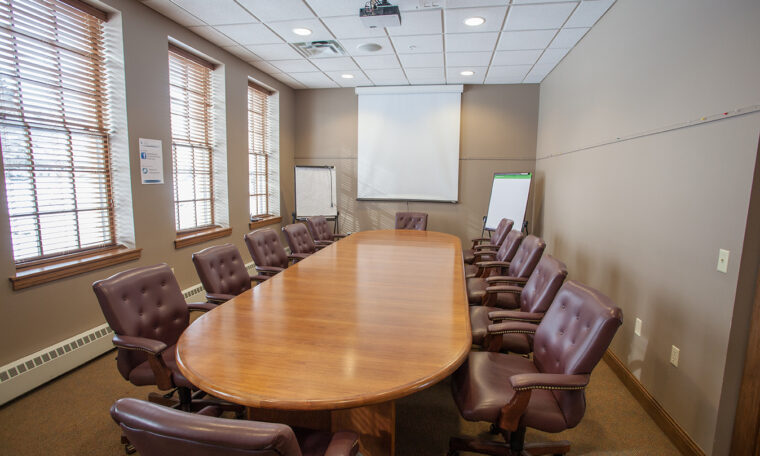
Room Dimensions:
14’x24′
Room Capacity:
12-14
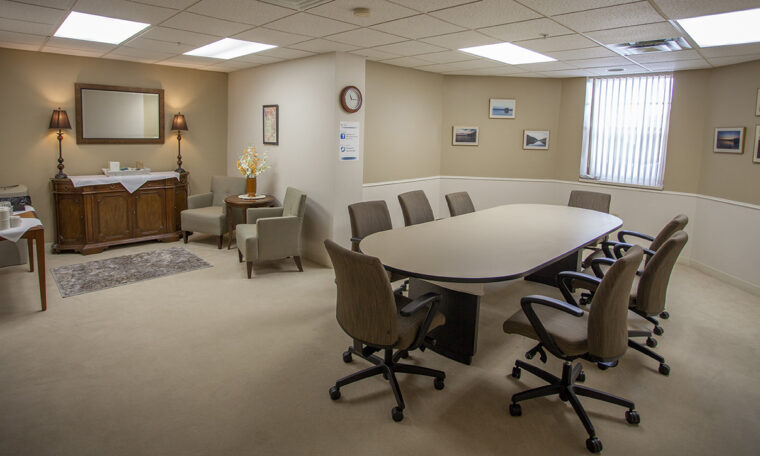
Room Dimensions:
12’x20′
Room Capacity:
8-10
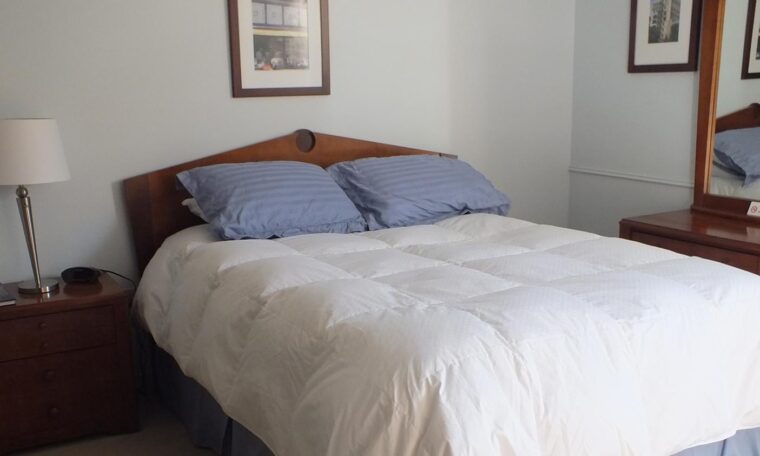
We have a total of 15 rooms and 18 beds to accommodate your group. We have 12 single rooms with one queen size bed and 3 double rooms with two full size beds.
Each overnight room has its own private bath and vanity area, working desk, reading chair, and standard toiletries and amenities are also in the rooms.
There are no TVs or refrigerators in the rooms, however there is wireless internet throughout the building, and we do have a very comfortable guest lounge to gather in, which has plenty of seating for conversations, TV watching or connecting with each other. There is also a kitchenette that includes a microwave, refrigerator, and toaster oven for your use during your stay.
Nicole was so helpful with planning our first in-person meeting again. Our group loved having the windows and doors open, access to the patio, sanitizer stations – great job, will definitely keep recommending the venue and hope to be back soon.

Package Rates
All packages at the Minnesota Humanities Event Center include: space in one of our meeting rooms, free wireless internet; free parking; an ADA compliant, smoke-free facility; historic building located in a park setting; no added gratuities. We can also customize the package rates and adjust them according to your needs. Breakout and support spaces are available for an additional charge.
Half-day (morning) includes continental breakfast and luncheon (beverages, starter, main entrée, and dessert). Or: Half-day (afternoon) includes luncheon and afternoon break service (beverages and two items from our snack menu). Morning hours are typically between 7:00 a.m. and 1:00 p.m.; afternoon hours are between noon and 5:00 p.m.
Standard Rate: $54.00 per person per day
Government/Nonprofit Rate: $49 per person per day
20-person minimum for weekend events
Includes continental breakfast and luncheon (beverages, starter, main entrée, and dessert), afternoon break service (beverages and two items from our snack menu) and all-day beverage service. Hours are typically between 7:00 a.m. to 5:00 p.m.
Standard Rate: $74.00 per person per day
Government/Nonprofit Rate: $69 per person per day
20-person minimum for weekend events
Includes dinner (beverages, starter, main entrée, and dessert) and evening break service (beverages and two items from our snack menu). Evening hours are typically between 5:00 and 10:00 PM
Standard Rate: $54.00 per person per day
Government/Nonprofit Rate: $49 per person per day
20-person minimum for evening events
Shorter meetings, receptions, and special events also may be arranged at the Minnesota Humanities Center. Prices will be quoted on an event-by-event basis. We can also customize the package rates and adjust them according to your needs.
- Telephones and Polycom Conference Phone
- Logitech Meet-Up Wide-Angle Conference Web Cam with Extension Microphone
- Laptop Web Cameras
- Laptop Microphone
- White Boards with dry-erase markers
- Easels and Easel Paper
- Podiums
- Laptops
- A/V Carts
- HDMI, VGA, and other adaptors available to connect laptop or device to projector/TV
- LCD Projectors (ceiling mounted in Library and Commons)
- TV Monitors to hook up laptop to (wall mounted in Board Room and Ivy Room)
- Screens (mounted in the Library and Commons)
- Handheld or Lapel Microphone (2 of each available for Library and Commons use)
- High-speed Internet access (wireless connections are available with password posted in each room)
- 6’x18” and 8’x18” tables for display, registration, presenters, etc.
- 72” oval tables (can seat 7/table in the Library, 8/table in the Commons)
Everything ran smoothly and staff were available to assist at any time. Great experience!

Menus
At the center of many gatherings you will usually find food – and convening here is no different! Our catering staff have been cooking up healthy meals and helping people stay connected and nourished for over 25 years. Take comfort in knowing that we shop local when we can, choose fresh over frozen to prepare our meals, and cook with healthy ingredients to accommodate the many dietary restrictions we encounter every day with our guests.
Because of our intimate size and how we prepare meals, we can offer only one menu selection per meal; however special dietary needs can be accommodated with advance notice. If there are multiple groups booked, we allow the group that booked first to choose the menu. Rest assured that we will make sure the menu selection works for your group! Please inquire at the time of booking whether your group is the first to book. For customized, special events, we will work with you to develop a menu that can offer more than one menu selection.
Continental Breakfast
Continental Breakfast (comes with the Day Meeting Package and the Half-Day Meeting Package)
A selection of muffins/pastries; fresh fruit; a variety of juices, regular and decaf coffee, hot tea and water.
Heavy Continental Breakfast
Add yogurt, granola, and hard boiled eggs to the continental breakfast for an additional charge.
Hot Breakfast Selections
You may add any of the hot breakfast selections below to the continental breakfast for an additional per person charge.
Egg Bake
Eggs, cheddar cheese, diced ham, and spinach mixed together and baked until set custard style.
Vegetarian Breakfast Bake (can be made gluten free)
Ciabatta, spinach, mushrooms, onion, red pepper, cheese, eggs and cream.
The Classic
Scrambled eggs, bacon, and sausage.
Make your own Yogurt Parfaits
Vanilla yogurt served with an assortment of fresh seasonal berries and granola.
White Chocolate and Banana Stuffed French Toast
French toast stuffed with white chocolate and bananas, dusted with powdered sugar and topped with freshly
whipped cream.
Mini individual Egg Frittatas (can be made vegetarian)
A mixture of eggs, sausage, bacon, ham and seasonal vegetables topped with cheese and baked.
Cream Cheese and Cherry Stuffed French Toast
French toast stuffed with cream cheese and cherries. Dusted with powdered sugar and topped with whipped
cream.
We can offer only one menu selection per meal because of our intimate size, however special dietary needs can be accommodated with advance notice. If there are multiple groups booked at the Humanities Center, we allow the group that booked first to choose the day’s menu. Please inquire at the time of booking whether your group is the first to book.
Each offering is accompanied with a choice of either soup or a garden select salad tossed with our house vinaigrette, and your choice of dessert. All selections are served buffet style, but can be plated and served for an additional cost. If this is desired, please indicate this when making reservations.
Oven-crisped Chicken with Maple-Vinegar Sauce
A split chicken breast is seared and oven roasted, then basted with a tangy maple-vinegar sauce, and topped with almonds, cranberries and leeks. Served with roasted and mashed root vegetables and seasonal vegetables.
Open Face Turkey Sandwich
Buttered and grilled sourdough bread topped with simmered medallion of turkey, sautéed onions, a rich sage cream sauce and cranberry compote. Served with mashed potatoes and fresh seasonal vegetables.
Prime Rib Sandwich
A crusty baguette houses thinly sliced prime rib of beef bathed in au jus topped with sautéed onions and topped with gruyere cheese. Served with kettle fried potato chips and fresh seasonal vegetables.
Cobb Salad
Crisp romaine lettuce and peppery watercress tossed with crisp sautéed bacon, sliced avocado, crumbled Maytag bleu cheese, diced fresh tomatoes, poached chicken, and finally our homemade red wine vinaigrette.
Garden Wrap (Can be prepared as vegan.)
Big tortillas stuffed with spinach, sprouts, cucumbers, red onions, havarti dill cheese, cream cheese, mayonnaise and whole grain mustard. Served with an apple and red cabbage slaw, pickles and kettle fried potato chips.
Grilled Lemon-Thyme Chicken Piccata
Olive oil-marinated grilled chicken breasts, topped with capers, parsley, and lemon-thyme butter. Served with orzo and seasonal vegetable.
Meat Lasagna
Layers have ground beef, meat marinara sauce, and Parmesan cheese, which is baked until the top is golden.
Butternut Squash and Wild Mushroom Lasagna
Layers of lasagna noodles, spinach mixed with salted and peppered ricotta, simmered squash pureed and mixed with goat cheese, and all sorts of mushrooms sautéed in butter. Served with garlicky parmesan bread.
Curried Tofu Mango Stir-Fry (Vegetarian and Vegan)
Cubes of fried tofu tossed with a stir-fried combination of mushrooms, green peppers, scallions, red onions, sauced with mango chutney, and spiced just a bit.
Linguini alla Carbonara
Linguini tossed Parmesan cheese, eggs, Romano cheese and applewood smoked bacon, zucchini, red pepper all sautéed in olive oil.
Chicken Escoffier
An elegant and classic preparation of a breast of chicken doused with clarified butter, breaded with fresh breadcrumbs and sautéed until golden served with Arborio rice risotto and seasonal vegetables. The dish is finished with a ring of intensely flavored balsamic glaze.
Mesclun Salad with Dried Apricots and Spiced Nuts (Can be prepared with or without chicken.)
The tiny bursts of spiciness from the nuts are a pleasing counterpoint to the sweet and tangy bits of dried apricot, together making this a tasty salad.
Warm Insalata Caprese Sandwich
Oven-warmed Ciabatta bread, layered with mozzarella, tomatoes, basil and balsamic vinegar-mayonnaise. Served with garlic potatoes.
“Build Your Own” Lunch
These meals are reserved for groups of twenty people or more.
Each offering includes menu items shown in description and your choice of dessert.
Mac and Cheese Bar
Cavatappi (corkscrew) pasta loaded with a variety of cheeses and served with all the classics on the side: grilled chicken, bacon, turkey sausage, broccoli, green onions and Franks Buffalo Sauce.
Soup and Salad Bar
A make your own salad bar complete with mixed greens, diced chicken, and various toppings served with bread and your choice of two selections from our soup menu.
Fajitas
Grilled chicken and beef served with seared peppers and onions, refried beans, Spanish-style rice pilaf, warmed tortillas, tortilla chips, and a condiments bar. (There is no soup or salad starter with this choice.)
The Delicatessen
A selection of fresh breads, meats (roast beef, ham, turkey), cheeses, and vegetables. Served with soup, pasta salad and chips.
The Mediterranean
Curried chicken, seared peppers and onions, spicy yellow split peas, creamed curry spinach, basmati and lentils, and a salad served with a sweet dill dressing.
Italian Buffet
Two varieties of pasta and two sauces: chicken alfredo cream sauce and marinara with ground beef. Served with green salad in a seasonal vinaigrette dressing and garlic bread.
Chicken Satay
A selection of red curry-coconut milk vegetable stir fry, chicken satay, and jasmine sticky rice. Served with green salad in a seasonal vinaigrette dressing.
Chili and Baked Potato Bar
Build your own baked potato with your favorite toppings including: sour cream, cheddar cheese sauce, bacon bits, chives, and broccoli. Served with a classic chili.
Each offering is accompanied with a seasonal vegetable preparation, bread, a choice of either soup or a garden select salad tossed with our house vinaigrette, and your choice of dessert. All selections are served buffet style, but can be plated and served for an additional cost. If this is desired, please indicate this when making reservations.
Parmesan Dijon Chicken
Chicken breast bathed in Dijon mustard and coated with a mixture of breadcrumbs, parsley, chives and parmesan cheese. Roasted and dressed with a mayonnaise mustard blend. Served with roasted red potatoes and fresh seasonal vegetables.
Lasagna
Layers of pasta, parmesan and mozzarella cheeses, and meat sauce which is baked until the top is golden.
Butternut Squash and Wild Mushroom Lasagna
Layers of lasagna noodles, spinach mixed with salted and peppered ricotta, simmered squash pureed and mixed with goat cheese, and all sorts of mushrooms sautéed in butter. Served with garlicky parmesan bread.
Caraway Crusted Pork Tenderloin
Delicate medallions of pork tenderloin roasted with a robust caraway seed crust each served atop an herbed Carlsbad dumpling, doused in a rich mushroom veloute and accompanied by sweet and sour red cabbage.
Curried Tofu Mango Stir-Fry (Vegetarian and Vegan)
Cubes of fried tofu tossed with a stir-fried combination of mushrooms, green peppers, scallions, red onions, sauced with mango chutney, and spiced just a bit.
Spicy Buttermilk and Coconut Chicken
Roasted chicken breasts with a toasted coconut and buttermilk crust, topped with sweet Thai chili sauce. Served with cilantro lime basmati rice pilaf.
Tofu, Pepper and Zucchini Stuffed Mushroom (Can be prepared as vegan.)
Little diced pieces of tofu, zucchini, summer squash, and red peppers all tossed together with Worcestershire sauce and parmesan cheese, then stuffed into a Portobello mushroom cap and roasted. Served with Arborio rice risotto and fresh seasonal vegetables.
Dried Fruit Stuffed Pork Loin
Pork loin stuffed with ginger, apricots, prunes, garlic, caraway, and herbs and served with an enriched pan sauce, curried potatoes, and apples.
Herb-stuffed Turkey Breast Roulade
Turkey breast butterflied, stuffed with a variety of herbs, rolled up, wrapped in applewood-smoked bacon and roasted. Served with Arborio rice risotto and seasonal vegetables.
Beef Bourguignon
A classic dish of beef slowly braised in red wine and brown stock until extremely tender and deeply flavored is combined with sautéed mushrooms and pearl onions and then served with the rich wine sauce over egg noodles.
Chicken Noodle
Flavorful chicken broth with onion, carrot, celery, pasta and chunks of chicken breast.
Tomato Bisque (Vegetarian)
Creamy and chunky tomato soup flavored with dill.
Corn Chowder
A thick and chunky soup rich with sweet corn, and garnished with avocado and crème fraiche.
Sopa de Albondigas
Literally, “Meatball Soup”. A Mexican soup with small beef and chorizo meatballs in a light broth with tomatoes, rice and cilantro.
Tuscan Vegetable (Vegetarian and Vegan)
Rustic vegetable soup with cannellini beans, leeks, carrots, zucchinis, spinach and so on. Touched with herbs and parmesan cheese.
Chicken Wild Rice
Flavorful chicken broth with onion, carrot, celery, chunks of chicken breast and Minnesota-grown wild rice.
Butternut Squash
A velvety puree of butternut squash cooked with potatoes, with hints of cayenne and garnished with snipped chives.
Spice Cake with Apple Puree
Layers spiced buttermilk cake and Granny Smith apple puree are stacked up under a blanket of roasted walnut cream cheese frosting.
Apple Crisp
Sliced apples cooked with cinnamon, nutmeg, cloves and sugar. Coated with a streusel topping and baked.
Gourmet Cookies and Bars
This selection includes a variety of cookies and bars. The cookies could be sugar, oatmeal raisin, chocolate chip, peanut butter, or triple chocolate chip.
Strawberry Shortcake
Strawberries macerated in sugar, served over angel food cake and topped with whipped cream.
Dark Chocolate Mousse (Dairy and Egg free)
Light, rich and fluffy chocolate mousse!
Fruit Cup
Pineapple, Grapes, Strawberries and Cantaloupe
Please choose two options for your break service.
Trail Mix with dried fruit and nuts
Assorted Granola Bars
Chex Mix
Hummus and Pretzel Crisps or Pita Chips
Bagged Sweet Treats (Chips Ahoy, Oreos, and Golden Oreos)
Veggie Straws
Hand held, whole fruit (a variety of bananas, apples, pears, oranges)
Fresh Cookies and Bars
Apple Wedges with Peanut Butter and Caramel Dipping Sauce
Peanut Butter filled Pretzels and Chocolate Candy
Tortilla Chips and Homemade Salsa
Veggies and Dip
Hard Pretzels served with Honey Mustard Dipping Sauce
Bagged Snacks (a variety of Kettle Chips, Trail Mix, and Mixed Nuts)
Cold Hors d’oeuvres
Hors d’oeuvres are priced per 25 pieces, unless otherwise indicated.
Chips and Salsa, $30
Serves 25
Our chef’s homemade salsa served with tortilla chips.
Gourmet Cheese Plate, $89
Serves 25
Four to five varieties of artisan cheeses (a selection that may include and is not limited to: Tillamook sharp
cheddar, Gruyere, Stilton, Maytag Bleu, Gorgonzola picante, Chevre, Camembert, Sheep’s milk) served with a
variety of crackers, biscuits, breads, etc.
Simple Cheese Tray, $49
Serves 25
A selection of standard cheeses served with a variety of crackers.
Warmed Brie with Raspberry Jam and Almonds, $62
Serves 25
A wheel of creamy Brie cheese is topped with raspberry ham and sliced almonds, and then baked until just
warm. Served with crusty French bread.
Strawberry and Brie, $62
Slices of Limoncello-soaked strawberries, served with triple cream Brie. Served at room temperature, with
crusty French bread.
Grilled Vegetable Platter, $65
Serves 25
Assorted grilled vegetables, served with a spicy yogurt dip. Selection will vary, depending on season, but will
include at least 4 of the following: carrots, bell pepper, squash, zucchini, potatoes, and asparagus.
Raw Vegetable Crudités, $62
Serves 25
Assorted fresh vegetables, served with curry dip and Ranch dip. Selection will vary, depending on season, but
will include at least 4 of the following: carrots, celery, bell pepper strips, cherry tomatoes, jicama, yellow
squash, peapods, broccoli, cauliflower, radishes, cucumber.
Hummus & Pita, $42
Serves 25
A chickpea purée served with wedges of pita bread.
Shrimp with Fresh Cocktail Sauce, $88
Peeled, de-veined shrimp poached in shrimp stock, served with a homemade classic cocktail sauce.
Insalata Caprese Crostini, $64
Slices of baguette brushed with olive oil, grilled and topped with chopped fresh tomatoes, mozzarella and basil.
Deviled Eggs, $28
Hard-boiled eggs halved and filled with a mixture of egg yolk, mustard, and mayonnaise, topped with a variety
of garnishes.
Mixed Nuts, $48
Serves 25
A combination of at least four of the following nuts: honey almonds, masala spiced peanuts, pecans, and spicy
cashews, walnuts, and macadamias.
Fruit Tray, $54
Serves 25
A selection of fresh, seasonal fruit.
Meat Assortment with Dollar Buns, $85
Serves 25
Add cheese slices, tomato, onions, and lettuce for an additional $40
An assortment cold sliced roast beef, ham, turkey served with buns and condiments
Hot Hors d’oeuvres
Hors d’oeuvres are priced per 25 pieces, unless otherwise indicated.
Chicken Tandoori, $54
Roasted pieces of chicken marinated in yogurt and spices with onion and peppers.
Sea Scallops Wrapped with Bacon*, $83
Large sea scallops wrapped with applewood smoked bacon, brushed with a mixture of lemon juice, chives,
olive oil, and garlic, then grilled.
*Contains pork
American Meatballs with Smoky Chipotle Sauce, $44
Seared meatballs in a chipotle tomato sauce.
Pork Satay and Pineapple*, $54
Satays of marinated pork shoulder skewered alternately with chunks of fresh pineapple, grilled, and garnished
with toasted white sesame seeds.
*Contains pork
Creamy Spinach and Artichoke Heart Dip, $54
Serves 25
The dip is made with spinach, artichoke hearts, garlic, onion, béchamel sauce, Worcestershire, Parmesan
cheese. Served with chunks of warm baguette.
Spanakopita, $67
A mixture of spinach, Feta cheese, scallions, and cream cheese inside a triangle of phyllo dough, baked until
crisp.
Asparagus Straws, $74
Blanched asparagus stalks are wrapped with thinly sliced Prosciutto de Parma, Parmesan cheese and phyllo
dough, then baked until the dough is crispy.
Beef Tenderloin Teriyaki, $57
Pieces of beef tenderloin marinated in a mixture of soy sauce, mirin, sugar, garlic, ginger, scallions and sesame
oil grilled and garnished with slivers of scallions.
Hot Crab Dip, $67
A hot dip made of cream cheese, mayonnaise, onion, lemon juice, Tabasco sauce, Old bay seasoning, and fresh
crabmeat. Served with slices of baguette bread for dipping.
Dessert Hors d’oeuvres
Black and White Chocolate Covered Strawberries, $48
Fresh strawberries dipped in dark or white chocolate.
Mini-Creampuffs with Two Sauces, $45
Small cream filled creampuffs, with chocolate and strawberry sauces.
Gourmet Cookies, $38
A combination of sugar, oatmeal raisin, chocolate chip, peanut butter, or triple chocolate chip cookies.
Nanaimo Bars, $48
All bars start with a chocolate graham crust base, then with a layer of custard topped with either the flavors of Cappuccino, Irish Crème, Peanut Butter and Nanaimo.
White Chocolate Raspberry Cream Cake, $43
Triple layered cake with white chocolate and raspberry cream filling.
Lemon Supreme Shortcake, $43
A triple layer shortcake of lemon cream and whipped cream
Beverages
Soda (Coke & Pepsi Products) $2 each
Bottled Water $2 each
Infused Water $15/dispenser (40 glasses) (No charge for plain water dispenser)
Coffee & Hot Tea $18/urn (14 cups)
Punch $35/dispenser (40 glasses)
Lemonade $35/ dispenser (40 glasses)
Iced Tea $35/ dispenser (40 glasses)
Sparkling Cider $9/bottle (8 glasses)
Use the button below to download the Minnesota Humanities Event Center Spring/Summer 2023 Menus.
Bottom line, this place was EXCELLENT! Everyone in our group loved it! Great rooms, great location (green space), great food, friendly staff! It exceeded my hopes which is why I am already planning my next event.
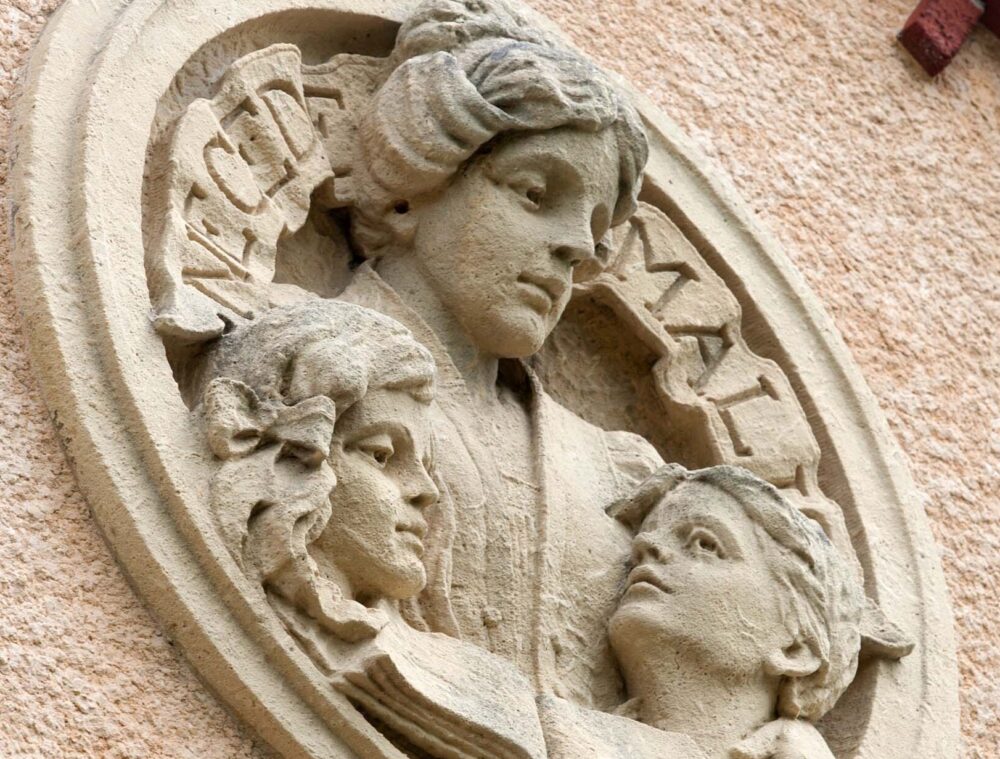
About Our Facility
Situated near the southern edge of Phalen Regional Park, bike and walking paths, beaches, a golf course, and other park amenities are within walking distance and easily accessible. Minutes from downtown St. Paul, there are plenty of options for offsite dining and entertainment.
Minnesota Humanities Event Center
987 Ivy Avenue East
Saint Paul, MN 55106
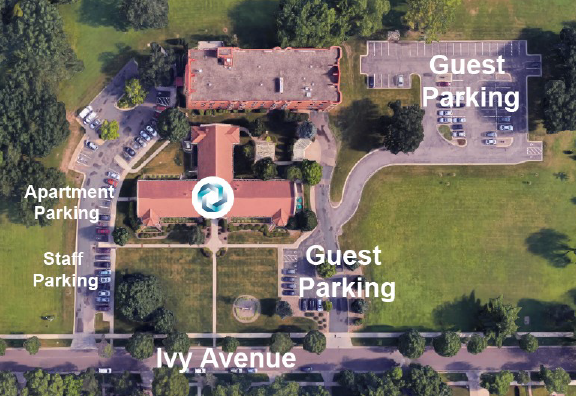
The Minnesota Humanities Center’s current location near Lake Phalen in St. Paul was built in 1924 as part of the original Gillette Children’s Hospital campus. It was built to provide a place where children could continue their education within the hospital setting.
Intrinsic to the missions of both Gillette Children’s Hospital and the Minnesota Humanities Center is the assumption that all people, regardless of their race, creed, class, or physical ability, should have the opportunity to learn. It is fitting, therefore, that the hospital’s former schoolhouse has been restored to serve as a center for humanities education.
Gillette Children’s Hospital was founded in 1897 to treat the orthopedic diseases of disadvantaged children. It moved to its Lake Phalen site in 1911; Dowling Memorial Hall — now the Humanities Center — was built as a memorial to Michael J. Dowling, who became a prominent educator and state legislator despite having lost his feet and hands to frostbite, triumphing in spite of his disability. Gillette Superintendent Elizabeth McGovern wrote in a 1921 letter:
“Mr. Dowling stood for opportunity for the physically handicapped and… the most fitting memorial that could be erected to his memory would be a school where children of normal mentality, physically handicapped, might have the opportunity to get an education that would fit them to go out into their communities and take their places as self-supporting citizens.”
Architectural researcher Paul Larson notes that though architect Clarence H. Johnston favored separate cottages for most of the institutions he designed, the Gillette West Wing was built under a single roof to accommodate patients. The structure was originally a single floor with K-12 classrooms, millinery and watch-making workshops, an auditorium and a library built in the “telephone pole” plan which made the entire building accessible from one wide hallway. There were no tricky corners or stairs to hinder wheelchairs and gurneys. The “Spanish style” stucco and tile exterior was inexpensive, was impervious to harsh Minnesota weather and allowed for large windows in every room. This was very important to Gillette’s method of sun-treatment for the patients (and very pleasant for the guests and staff today).
It is believed that Dowling Hall was left standing after the rest of the hospital was demolished because it was one of the more recent and decorative buildings. The graceful portico and elegant marble floors speak for themselves. The delightful carved tiles were most likely imported from Henry Chapman Mercer’s Moravian Pottery and Tiles Works in Doylestown, Pennsylvania.
The whimsical plaster sculptures, on the other hand, remain something of a mystery. Based on the appearance and context, we believe they were carved by the St. Paul-based Brioschi-Minuti Company, which was responsible for Columbus statues in St. Paul and Chicago, the interiors of the Basilica of St. Mary and the State Theater, and other important artistic decoration in the Midwest during the 1910s-1940s. Johnston’s transfer ledgers show that he worked several times with Carlo and Amerigo Brioschi from 1920 to 1935, even designing the Brioschi mausoleum.
The figures in the atrium of the building are small, contorted American Indians, Redcoats, and Pilgrims, all taking aim at some fierce enemy. These may have been based on figures that appeared in a popular children’s reader of the 1920s. Nestled among the grapevine moldings in the Commons, the “Humanities Trolls” are amazingly appropriate for the Humanities Center. The same sort of disfigured men — knees drawn up, hands gnarled — are depicted reading a book, peering at a globe, singing songs, and playing an instrument.
Two years after the Gillette Children’s Hospital moved to downtown St. Paul in 1977, the entire 13-acre campus was razed except the west wing. Although various organizations and developers expressed interest in the property, it remained vacant for 18 years until the Humanities Center renovated the building at a cost of $2.57 million. In 1996 the Humanities Center opened and now houses a full-service meeting and event center, 15 administrative offices, and 15 overnight guest rooms.
Our building is also home to the offices of the Minnesota Humanities Center (MHC), a statewide nonprofit that envisions a just society that is curious, connected, and compassionate. Our building hosts many educational and community events that complement our programmatic work as it reinforces the MHC as a place where people gather, strengthen connections, and participate in meaningful dialogues.
MHC is committed to providing a safe, clean, and healthy environment for our employees and customers. Our Commitment to Guest Safety outlines how we are doing this.
We believe keeping everyone safe is a shared responsibility. Review and share our Client Commitment with your attendees prior to your event to ensure public health and safety.
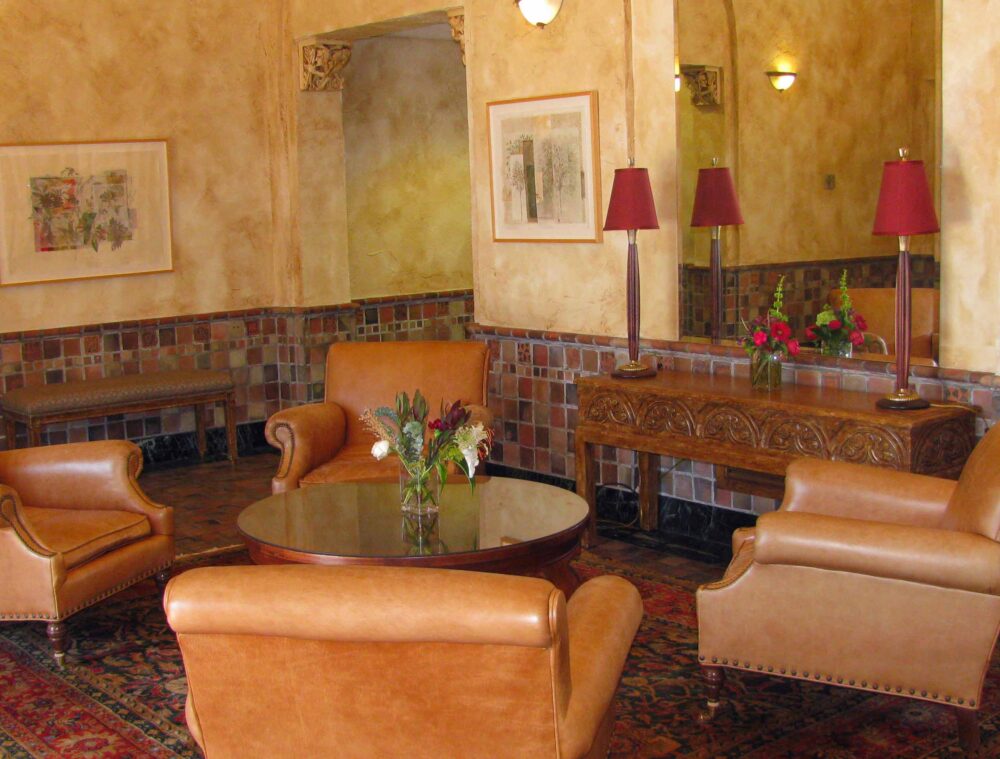
Event Center Image Gallery
View more photos of our building, meeting, and overnight spaces. Click on photos to view larger images.



